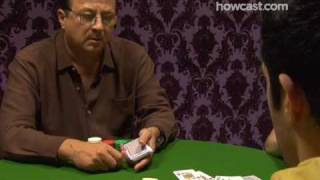Learn Texas Holdem Video Source & Info:
Like these Gambling Lessons !!! Check out the official app http://apple.co/1HCxrup
Watch more Poker 101 videos: http://www.howcast.com/videos/83-How-to-Play-Seven-Card-Stud
Seven Card Stud was the preferred game of good guys and bad guys alike in the Old West—and its popularity spread worldwide during World War II thanks to American G.I.’s.
Step 1: Choose dealer
Choose a dealer. One way to do this is to deal cards around the table face-up. The first player to get an Ace is the dealer.
Step 2: Shuffle & cut
The dealer shuffles and cuts the deck of cards.
Step 3: Ante up
Each player “antes up” by placing an amount predetermined by the dealer into the pot.
Step 4: Deal cards
The dealer deals around three times, distributing a card at a time to each player, for a total of three cards each. The first two cards—called “hole cards”—are dealt face-down; the third card—called a “door card”—is dealt face-up.
Step 5: Opening bet
The dealer announces the lowest card showing, and a round of betting follows, opened by the player holding the lowest card and proceeding clockwise to his or her left. The opening bet is called a “bring in” and is usually a small, nominal amount.
Tip
If two or more players hold low cards of the same value, the cards are then ranked alphabetically by their suit—club, diamond, heart, spade. So if four players hold Twos, the one holding the Two of clubs makes the “bring in” bet.
Step 6: Deal 4th & bet
The dealer deals a fourth card—called “fourth street” or “the turn”—face-up to each player. The dealer announces the highest card or hand showing and a round of betting follows, started by the player holding that high card or hand and proceeding clockwise to his or her left.
Tip
It’s also customary for the dealer to announce any pairs that may be showing after the fourth card is dealt and any raises that occur during betting.
Step 7: Deal 5th & bet
The dealer deals a fifth card—called “fifth street”—face-up to each player. The dealer announces the highest card or hand showing and betting again follows, started by the holder of that high card or hand and proceeding clockwise to his or her left.
Step 8: Deal 6th & bet
The dealer deals a sixth card—called “sixth street”—face-up to each player. The dealer announces the high card or hand and betting again follows, started by the holder of that high card or hand and proceeding clockwise to his or her left.
Step 9: Deal 7th & bet
The dealer deals the final card—called “seventh street” or “the river”—face-down to each player. The dealer announces the highest card or hand showing and a final round of betting occurs, started by the holder of that high card or hand and proceeding clockwise to his or her left.
Step 10: Show & win
When the betting has stopped, every player still in the game turns their hand face-up, starting with the dealer. The player holding the best five-card poker hand wins the game.
Did You Know?
A poker hand of two black Aces over two black Eights is called a “Dead Man’s Hand”—according to legend, those are cards Wild Bill Hickok was holding when he was gunned down in 1876.
Source: YouTube








when are cards burned?? :/
What happens if you run out of cards in the deck for example in a 8 player game?
:46
Don't get greedy! Cash-out your winnings METHOD INSIDE https://t.co/2SzhnDI7I4
and if'n yous get's caught countin' cards, we'll 'ave to take yous out back and rough you up, see?
His voice is like de niro's
When can you look at your hole cards? As soon as you get them after the ante? So 3rd street?
232
So, when do you get to look at your hole cards?
It bothers me that they dont mention the 4th street rule:
"A double bet can be made ONLY by the player in 1st position if they are showing an EXPOSED pair.".
This is a game tatctic and an important rule for stud games…
That player (pair holder) has the option to bet the lower or the higher limit. Some games allow the players afterwards the same betting option in this instance. But, it always goes for the player holding the pair.
Per professional casino dealer & "The Gameday Poker Almanac: Offical Rules of Poker, pg. 173"